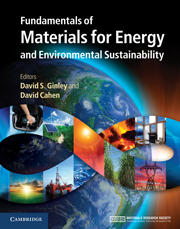Book contents
- Frontmatter
- Contents
- Contributors
- Preface
- Acknowledgments
- Part 1 Energy and the environment: the global landscape
- Part 2 Nonrenewable energy sources
- Part 3 Renewable energy sources
- 17 Solar energy overview
- 18 Direct solar energy conversion with photovoltaic devices
- 19 Future concepts for photovoltaic energy conversion
- 20 Concentrating and multijunction photovoltaics
- 21 Concentrating solar thermal power
- 22 Solar thermoelectrics: direct solar thermal energy conversion
- 23 Off-grid solar in the developing world
- 24 Principles of photosynthesis
- 25 Biofuels and biomaterials from microbes
- 26 Biofuels from cellulosic biomass via aqueous processing
- 27 Artificial photosynthesis for solar energy conversion
- 28 Engineering natural photosynthesis
- 29 Geothermal and ocean energy
- 30 Wind energy
- Part 4 Transportation
- Part 5 Energy efficiency
- Part 6 Energy storage, high-penetration renewables, and grid stabilization
- Summary
- Appendix A Thermodynamics
- Appendix B Electrochemistry
- Appendix C Units
- Index
- References
30 - Wind energy
from Part 3 - Renewable energy sources
Published online by Cambridge University Press: 05 June 2012
- Frontmatter
- Contents
- Contributors
- Preface
- Acknowledgments
- Part 1 Energy and the environment: the global landscape
- Part 2 Nonrenewable energy sources
- Part 3 Renewable energy sources
- 17 Solar energy overview
- 18 Direct solar energy conversion with photovoltaic devices
- 19 Future concepts for photovoltaic energy conversion
- 20 Concentrating and multijunction photovoltaics
- 21 Concentrating solar thermal power
- 22 Solar thermoelectrics: direct solar thermal energy conversion
- 23 Off-grid solar in the developing world
- 24 Principles of photosynthesis
- 25 Biofuels and biomaterials from microbes
- 26 Biofuels from cellulosic biomass via aqueous processing
- 27 Artificial photosynthesis for solar energy conversion
- 28 Engineering natural photosynthesis
- 29 Geothermal and ocean energy
- 30 Wind energy
- Part 4 Transportation
- Part 5 Energy efficiency
- Part 6 Energy storage, high-penetration renewables, and grid stabilization
- Summary
- Appendix A Thermodynamics
- Appendix B Electrochemistry
- Appendix C Units
- Index
- References
Summary
Focus
During the last 30 years, wind energy technology has emerged as the leading renewable alternative to electrical power production from fossil fuels. Commercial development and deployment, driven by lower capital costs, technical innovations, and international standards, continue to facilitate installed capacity growth at a rate of 30%–40% per year worldwide [1]. Utility-class machines exceed 2 MW, with robust designs providing 95%–98% availability. Future technology advances will focus on lowering the cost of land-based systems and evolving next-generation technology for ocean deployments in both shallow and deep water.
Synopsis
Wind energy technology is poised to play a major role in delivering carbon-free electrical power worldwide. Advanced technology and manufacturing innovations have helped the cost of wind energy drop from $0.45 per kW·h 30 years ago to $0.05–$0.06 per kW·h, thus positioning wind energy to be directly competitive with fossil-fuel power generation. In 2009, wind technology accounted for 39% of all new electrical generation in the USA [2]. Worldwide, wind deployment continues to penetrate new markets, with power-plant installations spanning months instead of years. In the European Union, cumulative wind power capacity increased by an average of 32% per year between 1995 and 2005, reaching 74,767 MW by the end of 2009 [3]. The USA leads the world in total installed capacity, while India and China are emerging as major potential markets. Wind energy can no longer be considered European-centric and has become an international alternative to fossil-fuel power generation.
- Type
- Chapter
- Information
- Publisher: Cambridge University PressPrint publication year: 2011

